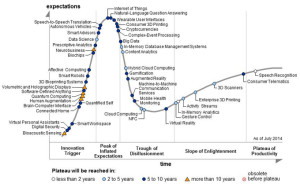
Back in February, at a Mobile World Congress session about wearables, one of the panelists made the key observation of the year:
“Hardware is hard.”
Is it ever. Anyone can pull together a Photoshop drawing, build a 3D printed gadget and make a YouTube video. Anyone can get on Kickstarter or Indiegogo, and anyone can hire a PR company. Building it and shipping something? That’s hard. Real hard.
Hardware is hard enough that the biggest companies had trouble with it this year. Fitbit suffered the financial and reputational embarrassment of pulling a product at the beginning of the year, and then couldn’t get two successors out the door by the holiday season. (It didn’t seem to hurt them much; they’re still the industry leader in the smartband market by a wide margin.) Jawbone missed the holiday with the UP24. Apple — well, we all know about the Apple Watch, although Apple never claimed they were going to ship this year anyway.
Google Glass? Nope.
Healbe Gobe? Despite its president swearing up and down that it would ship in the summer and then the fall — nothing. (And never mind that its central health claims still appear to be nonsense.)
The Intel/Opening Ceremony MICA cuff? No. Will.i.am’s PULS? Sadly, no.
Drum Pants? No. Skully Helmets? No.
It’s not all grim. Zackees shipped. And so did Visijax, a waycool LED-enhanced bicycling jacket that we’ve done some marketing consulting for.
On the good side, of course, things did ship, although often in limited quantities. Samsung came to shelves with a long line of wristware. Misfit segmented the market nicely by price and design. Lumo shipped its posture monitor. Sensoria’s socks made it to backers (we think). Moto360 came out as expected, as did the Withings Activé and a lovely Michael Bastian smartwatch. And the enterprise wearables business continues to percolate. So it wasn’t all grim.
Hardware is hard and unforgiving. Designers have to make product decisions based on technology targets that are faint and moving away from them. Managing a manufacturing process that’s 10,000 miles away in China is difficult. Keeping impatient investors in line is tricky. Too often, one way to keep heat on a project is to feed an all-too-compliant and competitive media, trying to make it look like a product is actually real, instead of some digital files, extended credit lines, and a stomach full of acid.
For our part, we tried to separate Kickstarter campaign hype from the actual product. We got better at it as the year went by, but we as snarky as we are, we were credulous too often. We can do still better. And that’s why we’re not naming Products of the Year this year; it’s too hard to separate real products from sort-of products.
The good news? There’s lots of great stuff in the pipeline, and hope springs eternal. From here, it looks like there’s gonna be a hell of a first quarter 2015…